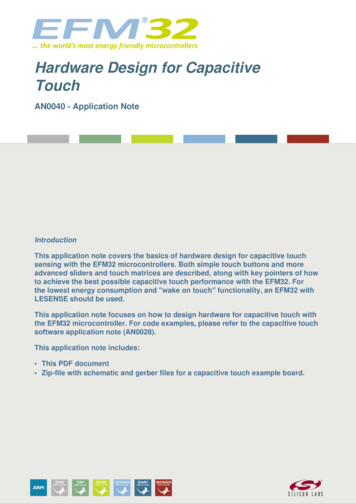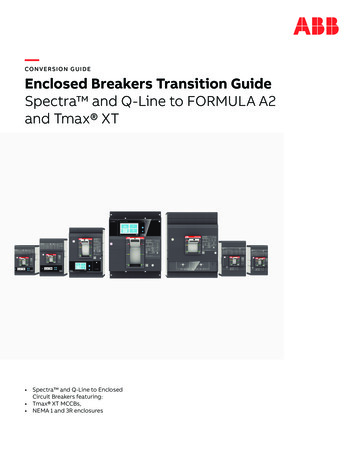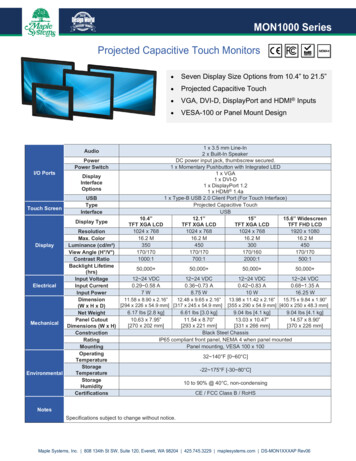
Transcription
.the world's most energy friendly microcontrollersHardware Design for CapacitiveTouchAN0040 - Application NoteIntroductionThis application note covers the basics of hardware design for capacitive touchsensing with the EFM32 microcontrollers. Both simple touch buttons and moreadvanced sliders and touch matrices are described, along with key pointers of howto achieve the best possible capacitive touch performance with the EFM32. Forthe lowest energy consumption and "wake on touch" functionality, an EFM32 withLESENSE should be used.This application note focuses on how to design hardware for capacitive touch withthe EFM32 microcontroller. For code examples, please refer to the capacitive touchsoftware application note (AN0028).This application note includes: This PDF document Zip-file with schematic and gerber files for a capacitive touch example board.
.the world's most energy friendly microcontrollers1 IntroductionCapacitive sensing is a technology now widespread across different industries. High performancecapacitive sensors are capable of high resolution measurements of proximity, position, humidity, fluidlevels or acceleration of a conductive target. Lower cost capacitive touch sensors are less advanced areand mostly used for human-device interfaces by measuring the capacitance change when a user's fingeris nearby. These kind of sensors are increasingly common in devices with a human interface of all sorts.This application note will focus on sensors used to interface with human users in applications focused onvery low power. Low power capacitive touch with the EFM32 can be implemented at low cost and bringmany advantages over mechanical switches. They have no moving parts which gives less degradationover time, with usage and with environmental changes. The EFM32 capacitive touch feature is primarilymade for implementing capacitive touch buttons and sliders with very low energy consumption, but itcan also be adapted to other capacitive sensing applications.All EFM32's with analog comparator(s) are capable of capacitive touch. For the absolute lowest energyconsumption, EFM32's with LESENSE (Low Energy Sensor Interface) can use this peripheral to scanseveral touch pads continuously and only wake the CPU when a touch is detected.Regardless of which EFM32 is used for capacitive touch sensing, the design of printed circuit boards orsimilar hardware for capacitive touch sensing follows the same guidelines which are explained furtherin this document.2013-09-16 - an0040 Rev1.022www.silabs.com
.the world's most energy friendly microcontrollers2 Capacitive Sensing BasicsFigure 2.1. Capacitive Sense OverviewC touchVirtual groundCopperOverlayLam inate (FR4)GroundGoundC base2.1 Working PrincipleThe working principle of a capacitive touch (or proximity) sensor is to measure the change in capacitanceof a given, and otherwise constant, capacitance when approached or touched by a larger body suchas a human finger or hand. The capacitive touch pad can be implemented with different technologies,ranging from a trace on a printed circuit board to various conductive coated surfaces like glass or plastic.The PCB approach is often combined with an overlay or cover panel, typically made of some kind ofplastic or glass.When implementing a capacitive touch sensor there are a few possible configurations which can becategorized in two different types; self- and mutual-capacitance. The difference is between which twonodes the capacitance is measured. It can either be between the touch pad and another electrode withdifferent potential than ground, which is the mutual-capacitance type of setup. Or it can be between thetouch pad and ground, which is the self-capacitance type of setup. The EFM32 is designed for selfcapacitance measurements where the change in capacitance between a touch-pad and ground is themeasured entity.The EFM32s way of measuring changes in capacitance is by using the analog comparator to set upan RC relaxation oscillator. The oscillating circuit includes the capacitance between the touch-pad andground as the capacitive element. The implementation can be seen in Figure 2.2 (p. 4). By countingthe number of oscillations during a fixed time interval, an indication of the capacitance in the RC circuitis acquired. This count value can be compared against a threshold value to determine if a sensor istouched or not because a change in count value indicates a change in capacitance.2013-09-16 - an0040 Rev1.023www.silabs.com
.the world's most energy friendly microcontrollersFigure 2.2. Analog comparator RC relaxation oscillatorButtonsPOSSELVDD SCALEDVDD/ 4The quality of a touch measurement is correlated with how much the capacitance between the pad andground changes upon human touch. This can be directly translated to how large the observed changein count value is when a human finger touches the pad compared to the non-touched count value. Thegoal of hardware design for capacitive touch is to maximize this change when a human finger touchesa pad as well as minimize sources of noise.Figure 2.1 (p. 3) illustrates a typical capacitive touch button with a finger approaching. The term"virtual ground" refers to the fact that a finger placed close to the capacitive touch pad acts as an electricalbody which has a finite impedance to the capacitive touch circuit's own ground.The typical parameters of the RC oscillator and the capacitance of a pad is listed below. Frequency: 100 kHz - 1.5 MHzCapacitance of pad: 5 pF - 15 pFChange in capacitance upon touch: 0.3% - 50%Typical measurement window: 0.2ms - 4ms2.2 Signal-to-Noise RatioThe change in capacitance when a finger is placed near the sensor element is generally very small. Thismeans that noise in the measurements needs to be kept even smaller to be able to reliably differentiatebetween actual touches and noise. The signal-to-noise ratio (abbreviated SNR) is a way to quantitativelycompare the performance of different solutions, both hardware- and software-wise.The SNR definition used in this application note is the same as for the capacitive touch softwareapplication note (AN0028). Any definition of SNR could in principle be used to compare differenthardware designs. The one chosen here is based on the measurement principle that is used by theEFM32.A given capacitance between the pad and ground is represented by a count value as described inSection 2.1 (p. 3) . The "signal" refers to the difference between the average count for touch andno touch. The ratio between this difference and the noise for an untouched button is the SNR. SeeFigure 2.3 (p. 5) for an example of SNR. As illustrated the target is to keep the SNR higher than 5.The term "noise" as used in this document refers to the absolute peak to peak difference observed inthe count values for otherwise static conditions. This is a useful definition since the statistical distributionis unknown and less frequently occurring peak values should be taken into account because they canlook like false touches.2013-09-16 - an0040 Rev1.024www.silabs.com
.the world's most energy friendly microcontrollersNoteAs a rule of thumb, the SNR should be above 5.When developing a capacitive touch application one should check that the SNR criterion is fulfilled forthe actual PCB with the final overlay (same material and thickness that will be used). For evaluation ofthe SNR the reader is referred to the capacitive touch software application note (AN0028).Figure 2.3. Signal to noise ratioNo Touch ValuesCount ValueNoise [e]Signal 5*eTouch Values1 2 3 . NSam ple #2.3 External DisturbancesExternal disturbances and environmental changes that can affect either the actual capacitance of asensor or a change in the measured capacitance are listed below. Some of these can be dealt with byimproving the hardware design (marked "hardware"). Some are inherent with the working principle ofthe capacitance measurement and should be handled by software (marked "software"). Radiated and conducted noise from other components, traces and power supply. (Hardware)Changes or noise in supply voltage. (Software/Hardware)Changes in temperature. (Software)Changes in humidity. (Software)Jitter in the low frequency (LF) oscillator frequency. (Hardware)This document focuses on minimizing the hardware related disturbances. The ones marked software isdiscussed in the capacitive touch software application note (AN0028).2013-09-16 - an0040 Rev1.025www.silabs.com
.the world's most energy friendly microcontrollers3 Sensor DesignHow the actual touch pads and printed circuit board are designed has a significant impact on theperformance of the capacitive touch solution. Parameters such as size and shape of the pads andhow the signals are routed affects the signal integrity. The following section discusses what affectsperformance and best design practices.3.1 Touch ButtonsFor simple touch buttons there is mainly one parameter of the pad itself that matters the most; size. Theshape and how far apart the pads are placed should also be considered to minimize false detection onneighboring pads.3.1.1 Button ShapeA round button is best, but other shapes works as well. The corners should be rounded as much aspossible, this will minimize stray field lines and focus the strongest field right above the button itself. SeeFigure 3.1 (p. 6) for an illustration of the touch button parameters; D - Diameter/Size, S - Spacingand ground clearance. The partly covering hatched ground and ground clearance are explained furtherin Section 4.1.2 (p. 10) .Figure 3.1. Simple Button DesignPrim aryLayerHatched GroundDGND ClearanceSecondaryLayerSTouch PadSignalsTouch PadGND3.1.2 Button SizeThe size of the buttons should be similar to the footprint of a touching finger. For circular pads thisequates to a diameter of approximately 15 mm. Any diameter between 10 mm and 20 mm is fine. Theexception to this would be proximity sensing and sensing through thick overlays. To increase the strengthof the field further away from the surface of the overlay, the pad can be made larger. For an illustrationof how the pad size affects SNR through different overlay thicknesses, see Figure 4.2 (p. 11) .3.1.3 SpacingIt is important that the touch pads are spaced far enough apart so that a touch does not also triggerneighboring pads. This can be handled by software as well, because almost always, one of the padswill have the strongest signal.The spacing is also dependent on the thickness of the overlay. For thin overlays the signal will in generalbe much stronger on the touched pad than the neighboring pads compared to thicker overlays. As ageneral rule, the spacing between the border of two pads should be equal to or greater than the overlaythickness.2013-09-16 - an0040 Rev1.026www.silabs.com
.the world's most energy friendly microcontrollers3.2 SlidersFor sliders, the most significant difference from buttons is that two or more pads will be affected by asingle touching finger at the same time. In practice this means that the pads are placed closer togetherand software interprets the finger's position by interpolating measurements from several pads.3.2.1 Simple SliderA simple slider can be implemented as illustrated in Figure 3.2 (p. 7) . The slider has 5 pads whichare spaced close together with an interleaving design. The interleaving allows for a linear transition inmeasured capacitance on the different pads when a finger is moved from one side to the other. Theactual position is deduced by software from the measurements on the different pads.Figure 3.2. Simple Slider DesignHigh resolution, high pin countLow resolution, low pin count3.2.2 Duplexed SliderIf a longer slider with more pads is desired, but the amount of capacitive touch pins from the MCU islimited, a duplexed slider can be used. The requirement is that only one finger is expected to touch theslider at any moment in time. By connecting two and two pads together as shown in Figure 3.3 (p. 8), software can deduce which pad was actually touched by finding the pad which also has neighboringpads with an increased capacitance.2013-09-16 - an0040 Rev1.027www.silabs.com
.the world's most energy friendly microcontrollersFigure 3.3. Duplexed Slider DesignEFM32Touching finger12342413Signal levelsCorrelatedpatternNon- correlatedpattern3.2.3 Radial SliderBoth the simple and duplexed slider can be turned into a radial slider by connecting the two ends togetheras shown in Figure 3.4 (p. 8) .Figure 3.4. Radial Slider Design128374653.3 Two Dimensional Touch ArraysThe same principle as the duplexed slider can be utilized to make two dimensional keypads or similardesigns. The limitation with one finger at a time applies here as well. An example of a 12 keyed keypadis illustrated in Figure 3.5 (p. 9) . Software needs to handle the translation between which differentpins are touched and which key that has actually been touched.2013-09-16 - an0040 Rev1.028www.silabs.com
.the world's most energy friendly microcontrollersFigure 3.5. Two Dimensional Matrix KeypadRow 1Row 2Row 3Row 41 2 34 5 67 8 9* 0 #Colum n 1Colum n 2Colum n 33.4 Proximity SensingProximity detection can be accomplished by making a much larger pad, or a ring around smaller buttons/sliders. The larger area will set up a stronger electric field, extending further from the device than thefield from small buttons/sliders does. The limitation is that a larger body of "virtual ground" is neededto affect the capacitance. This is fine for most applications since the proximity detection is supposedto detect the presence or closeness of a hand, foot or similar. Figure 3.6 (p. 9) illustrates how aproximity ring can be implemented around normal touch buttons.Figure 3.6. Proximity Sensing PadProx im ity PadProx im ity Padsignal2013-09-16 - an0040 Rev1.02Button 1signalGround fill or open areaButton 2signalButton 3signal9Button 4signalwww.silabs.com
.the world's most energy friendly microcontrollers4 Capacitive Touch Product Design4.1 PCB DesignRegardless of the different button/slider designs there are a few PCB design guidelines to get the bestpossible SNR which applies to them all.4.1.1 Signal IntegrityTo minimize radiated noise from other components and traces on the PCB, the touch traces should bekept away from other signals and as short as possible. This means that if possible, no other signals orcomponents should be routed through the touch-area of the PCB. This applies to all layers of the PCB.If other traces must be placed through the touch area they should be kept as far away from the touchpad and touch traces as possible. They should cross perpendicular to the touch traces and not routedalongside, parallel to any touch traces.The touch traces should be taken down to the secondary side of the PCB at the edge of the touch padto get them as far away as possible from the touch surface. This will ensure that a touching finger onlyaffects the actual pads and not the traces.The traces should be kept thin, 0.2 mm for example, and not placed too close together in order to avoidthat they affect each other. The EFM32 senses capacitance on different channels sequentially, so thechance of the touch traces affecting each other should be minimal. A spacing of 0.5 mm is sufficient, themost important thing is to keep the traces short and away from noise sources.4.1.2 GroundHow much and how close the touch pads are to the ground pour affects the nominal capacitance. Alarge nominal capacitance gives high resistance against noise but the change in capacitance introducedby a finger nearby is also reduced. To keep the nominal capacitance relatively low, the ground pourshould be hatched. A fill percentage of 10-40% is fine when overlay thickness is less than 4 mm. Forthicker overlays, a less dense ground layer will result in less nominal capacitance and better responseupon touch (3-15% fill).The ground pour should be on the same side as the pads with a few millimeters clearance to the pads(1.5 mm - 4 mm). See Figure 3.1 (p. 6) for an illustration of simple buttons with ground pour.If protection against touches from the secondary side is needed, the secondary side should be filledwith ground pour which acts as shielding. This added shield will increase the nominal capacitance whichdecreases sensitivity and SNR, again the fill ratio of the shield can be reduced to affect the nominalcapacitance less, but this will also reduce the effectiveness of the shield. For a 10 mm button, theachievable overlay thickness is decreased with approximately 3 millimeters with the secondary sideshielded by a 100% filled ground layer. See Figure 4.1 (p. 11) for a comparison of SNR betweenground shield and no ground shield on the secondary side.2013-09-16 - an0040 Rev1.0210www.silabs.com
.the world's most energy friendly microcontrollersFigure 4.1. SNR affected by ground shieldSNR10001.5 cm pad without shield1 cm pad without shield1 cm pad with shield10010SNR 5, Sensitivity Lim itPlex iglass overlay m m101234567891011121314154.2 OverlaySince a capacitive touch button is actually a capacitor where a human finger acts as one of the plates,the distance and dielectric constant of the material between the touch pad and the human fingerdetermines the capacitance. The shorter the distance and the higher the dielectric constant, the higherthe capacitance. To reduce noise and possibly false touches on neighboring pads, it is important thatthe overlay does not flex when a finger touches the surface. The overlay should be glued or clamped tothe PCB so that they do not move relative to each other upon touch or other external forces.4.2.1 Overlay ThicknessThe thickness of the overlay is directly affecting the SNR that can be achieved for a given touch solution.Figure 4.2 (p. 11) shows the SNR achievable for different overlay thicknesses and button sizes withPlexiglas as overlay material.Figure 4.2. SNR affected by button pad sizeSNR10002 cm pad without shield1.5 cm pad without shield1 cm pad without shield10010SNR 5, Sensitivity Lim itPlex iglass overlay m m10122013-09-16 - an0040 Rev1.02345678119101112131415www.silabs.com
.the world's most energy friendly microcontrollers4.2.2 Overlay MaterialTwo typical materials used for overlays are glass or acrylic. Of these two, glass has the highest dielectricconstant and is therefore the "best" overlay material of these two. Higher dielectric constant for theoverlay material results in a stronger electric field further from the metal pad. Almost all of the mostcommon overlay materials are better than air, therefore the amount of air between the metal pad andthe overlay should be minimized. See Table 4.1 (p. 12) for a listing of the dielectric constant forcommon overlay materials.For fixing the overlay in place on top of the touch PCB a proper adhesive or clamping solution shouldbe implemented. An example of an acrylic bonding product is the 200MP series from 3M. Many otherproducts exists for different overlay materials. The important thing is to minimize the air-gap and distanceas much as possible.Table 4.1. Dielectric constants of typical materials used in front panelsMaterialDielectric ConstantAir1Paper3.8Glass3.7 - 10Water80Plexiglas2.6 - 3.5Polyimide3.4Polyethylene2.2Polystyrene2.4 - 2.7Polyethylene terephthalate (PET)3.7FR4 (fiberglass reinforced epoxy)4.2PMMA (Poly methyl methacrylate), acrylic plastic2.6 - 4Bonding adhesive, for example 3M 467MP/468MP2-34.3 Curved Touch SurfaceFor curved touch surfaces two simple options are described here, either a flexible PCB or implementinga metal spring to get the touch pad as close as possible to the users finger.4.3.1 Flex-PCBThe capacitive touch pads can be implemented on a flexible PCB. The connection between the mainPCB and the flex-pcb with the buttons will also be touch sensitive. The construction should be kept stableand away from noise sources. This solution is illustrated in Figure 4.3 (p. 13) .2013-09-16 - an0040 Rev1.0212www.silabs.com
.the world's most energy friendly microcontrollersFigure 4.3. Flexible PCB for Curved SurfacesOverlayGNDPadGNDFlex PCBConnectorPCB4.3.2 Spring to SurfaceAnother option to get the touch pad closer to the surface is to use metal springs between the PCB andthe underside of the top surface. This is illustrated in Figure 4.4 (p. 13) .Figure 4.4. Spring to Surface SolutionC touchTouch Area:Metal pad or inwardsspiraling springVirtual groundOverlayLam inate (FR4)GoundC base4.4 Other Considerations4.4.1 OscillatorThe accuracy of the RC relaxation oscillator solution used by the EFM32 to sense capacitance isdependent on a stable clock reference for the capture window. Therefore it is highly recommended2013-09-16 - an0040 Rev1.0213www.silabs.com
.the world's most energy friendly microcontrollersto implement a low frequency crystal oscillator (LFXO) when implementing capacitive touch with theEFM32. The SNR achievable with a crystal oscillator is around 30 times better than the SNR achievedwith the internal low frequency RC oscillator clock source.4.4.2 Electrostatic Discharge ProtectionUsually the combination of a PCB soldermask layer or overlay between the metal pads and a touchingfinger, and internal protection diodes in the MCU, is sufficient as ESD protection for the microcontrollerscapacitive touch pins. If a user can come in contact with the metal-pads directly, some added protectionshould be considered. A series resistor of 100 Ohm - 1 kOhm in combination with external ESDprotection diodes as illustrated in Figure 4.5 (p. 14) , will not affect the capacitive touch performancesignificantly.Figure 4.5. Optional Electrostatic Discharge ProtectionInternalOptionalESD protectionEx ternalVddMCU- pin100RTouch pad2013-09-16 - an0040 Rev1.0214www.silabs.com
.the world's most energy friendly microcontrollers5 SummaryHardware design for capacitive touch can involve a range of conflicting design requirements. Thisdocument includes some guidelines and ideas which should be considered when deciding betweenthe many trade-offs during product development. The most important tips regarding PCB layout forcapacitive touch is listed in the following table. Include an external low frequency crystal in the design. Less ground and larger pads makes a thicker overlay possible. Route the touch traces as short and clean as possible. Keep them clear of noisy signals andcomponents.The included zip file with a pcb-design for a tiny gecko device demonstrates how these rules cansuccessfully be followed in a two-layer design.NoteRemember that proper software calibration is required regardless of the PCB layout andproduct design.2013-09-16 - an0040 Rev1.0215www.silabs.com
.the world's most energy friendly microcontrollers6 Revision History6.1 Revision 1.022013-09-03New cover layout6.2 Revision 1.012012-11-12Added capacitive touch PCB design files.6.3 Revision 1.002012-03-07Initial revision.2013-09-16 - an0040 Rev1.0216www.silabs.com
.the world's most energy friendly microcontrollersA Disclaimer and TrademarksA.1 DisclaimerSilicon Laboratories intends to provide customers with the latest, accurate, and in-depth documentationof all peripherals and modules available for system and software implementers using or intending to usethe Silicon Laboratories products. Characterization data, available modules and peripherals, memorysizes and memory addresses refer to each specific device, and "Typical" parameters provided can anddo vary in different applications. Application examples described herein are for illustrative purposesonly. Silicon Laboratories reserves the right to make changes without further notice and limitation toproduct information, specifications, and descriptions herein, and does not give warranties as to theaccuracy or completeness of the included information. Silicon Laboratories shall have no liability forthe consequences of use of the information supplied herein. This document does not imply or expresscopyright licenses granted hereunder to design or fabricate any integrated circuits. The products mustnot be used within any Life Support System without the specific written consent of Silicon Laboratories.A "Life Support System" is any product or system intended to support or sustain life and/or health, which,if it fails, can be reasonably expected to result in significant personal injury or death. Silicon Laboratoriesproducts are generally not intended for military applications. Silicon Laboratories products shall under nocircumstances be used in weapons of mass destruction including (but not limited to) nuclear, biologicalor chemical weapons, or missiles capable of delivering such weapons.A.2 Trademark InformationSilicon Laboratories Inc., Silicon Laboratories, the Silicon Labs logo, Energy Micro, EFM, EFM32, EFR,logo and combinations thereof, and others are the registered trademarks or trademarks of SiliconLaboratories Inc. ARM, CORTEX, Cortex-M3 and THUMB are trademarks or registered trademarksof ARM Holdings. Keil is a registered trademark of ARM Limited. All other products or brand namesmentioned herein are trademarks of their respective holders.2013-09-16 - an0040 Rev1.0217www.silabs.com
.the world's most energy friendly microcontrollersB Contact InformationSilicon Laboratories Inc.400 West Cesar ChavezAustin, TX 78701Please visit the Silicon Labs Technical Support web chnicalsupport.aspxand register to submit a technical support request.2013-09-16 - an0040 Rev1.0218www.silabs.com
.the world's most energy friendly microcontrollersTable of Contents1. Introduction . 22. Capacitive Sensing Basics . 32.1. Working Principle . 32.2. Signal-to-Noise Ratio . 42.3. External Disturbances . 53. Sensor Design . 63.1. Touch Buttons . 63.2. Sliders . 73.3. Two Dimensional Touch Arrays . 83.4. Proximity Sensing . 94. Capacitive Touch Product Design . 104.1. PCB Design . 104.2. Overlay . 114.3. Curved Touch Surface . 124.4. Other Considerations . 135. Summary . 156. Revision History . 166.1. Revision 1.02 . 166.2. Revision 1.01 . 166.3. Revision 1.00 . 16A. Disclaimer and Trademarks . 17A.1. Disclaimer . 17A.2. Trademark Information . 17B. Contact Information . 18B.1. . 182013-09-16 - an0040 Rev1.0219www.silabs.com
.the world's most energy friendly microcontrollersList of .4.3.4.4.4.5.Capacitive Sense Overview . 3Analog comparator RC relaxation oscillator . 4Signal to noise ratio .
3 Sensor Design How the actual touch pads and printed circuit board are designed has a significant impact on the performance of the capacitive touch solution. Parameters such as size and shape of the pads and how the signals are routed affects the signal integrity. The following section discusses what affects performance and best design practices.










